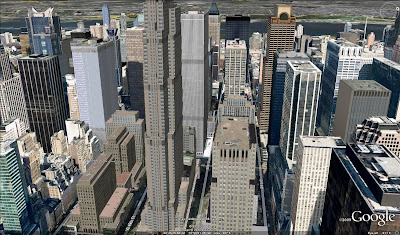
What a fantastic trip. Everything went smoothly. Started in Alexandria at 7:30, walked to the Braddock Street Metro station, took the yellow line to Chinatown, changed to the red line to Union Station, got a cup of coffee and a tuna wrap at Au Bon Pain, hopped on the 10:00 am Acela to Penn Station, arrived at 1:00. The GPS proved invaluable for navigation, though it took like 30 minutes to get a satellite fix because of the buildings. I walked around to get my bearings, saw the Empire State Building, then checked in at the hotel, the Radisson Lexington at 48th and Lex, perfect central location. Dropped my bag off, packed the GPS, tripod and camera in my backpack, and then went exploring. I went to the Chrysler Building next. I stopped at a pub called O'Donnell's and had a pint of Harp. The bartender was actually Irish! I then walked all the way to the Storefront for Art and Architecture (over 40 blocks), stopped at a Best Buy to get an AC charger for the GPS (which had run out of battery power), ate lunch at Lenny's and had an S1, a chicken salad sandwich on a kaiser roll, charged my GPS while eating. On the way, I was solicited by the director of his independent film to buy a DVD for $15. He told me the plot and seemed on the level, so I gave in a bought it. It is called "The Minority". Walking from the super tall buildings of midtown through Greenwich Village and into SoHo, I was amazed at the incredible diversity of the city.

I was really thirsty and went to this pub called "The Local Brewery" and had a pint of Ommegang Vitte, a very nice microbrew. I then saw one of the most beautiful women I have ever seen walk past. She must have been a model. I then found the Storefront for Art and Architecture. Walked from there to the Flatiron Building, then to Rockefeller Center. It was just past sunset by this time. There is an observation deck at the top of the GE Building called "The Top of the Rock" which was amazing. I got a couple great night shots, though it was not easy to find a good clear vantage point. There is nothing like the Manhattan skyline at night. Phenomenal. From Rockefeller Center, I casually found my way back to the hotel. Quite exhausted from the first leg of the journey, I tried to sleep, but my mind was racing from everything I had seen. Nice bed too. I didn't actually get to sleep until 2:00 am. Dragged myself out of bed at 9:00. Went down to grab something to eat at the hotel cafe. $20 for coffee, orange juice and a croissant (on top of a $330/night room)! I suppose I could have gone to the hotel Starbucks, but there was nowhere to sit. The Radisson Lexington was nice, though pricey, and I would stay there again. Very good location, it is actually right across the street from the Waldorf Astoria. After breakfast, I checked out of the hotel, and checked my bag with the storage desk. I then went to the Seagram Building, the Permanent Mission of India to the UN and MoMA. I hesitated whether or not I wanted to check out the exhibits as I still had a lot to see, but I am glad I did. What a collection! From MoMA, I walked to the Hearst Building and then to Columbus Circle. Then I went into Central Park and walked all the way up to the Rose Center for Space. I then cut across the Park and walked to the Guggenheim. I got on the subway and took it back to the hotel. I picked up my bag and took the subway to Penn Station. I then took a cab to what I thought was the address for the Whitney Museum. Fortunately, the Hudson River Park was worth seeing and the IAC building was 5 blocks away. I walked down there, and was astounded by it and the adjacent monstrosity. It was 5:45 by this time and my train was leaving at 7:00, so I needed to get back to Penn Station. I hailed a cab and made it back with plenty of time to spare. Had a tuna sandwich from Zora and a Corona. I was pretty whipped by this time as I must have walked 20 miles in two days. The train ride home was a breeze. Read "The Forever War" on my Kindle. Got into Union Station at 10:00pm. Took the Metro back to Alexandria. Contemplated walking the mile back home, but there was a cab right there. Got in at 11:30 last night. Awesome trip! I will fill in the details for each site with separate entries. I posted the pictures on Facebook here
Manhattan Photos


















